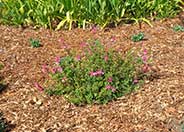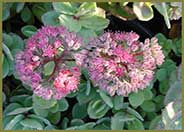
Common name:Crape Myrtle
Botanical name:Lagerstroemia indica
The new leaves of this species are 2" long, bright green, and tinged with bronze. Some cultivars have spectacular fall color. When it has a bare outline, its rounded seed capsules add interest. Its delicate flowers bloom in 6"-12" long clusters. The flower colors could be shades of red, rose, pink, purple, and white, blooming in summer. It thrives on heat, and new cultivars have been created that resist mildew. This tree prefers full sun and has low watering needs once it's established.

Common name:Lily of the Nile
Botanical name:Agapanthus hybrids
This evergreen ground cover/shrub will grow about 3' tall and has large green leaves with blue flowers (there is a white variety and dwarf varieties) that bloom in spring and summer. It will grow in all soils but prefers loam soil.

Common name:Blanket Flower
Botanical name:Gaillardia X grandiflora
This perennial has daisylike flowers in warm colors on sturdy stems. Plants form medium-sized clumps. It likes full sun and well-drained soil but tolerates poor soil and drought. It makes a great cut flower.

Common name:Baby Sage
Botanical name:Salvia microphylla 'Berzerkeley'
This compact beautiful sage reaches 1'-2' tall and 2'-3' wide. Leaves are evergreen, glossy, green and fragrant. Bright pink flowers cover the shrub from spring through fall. If you prune in late winter, you will get more blossoms. This plant attracts hummingbirds and butterflies. It prefers full to part sun and low watering requirements once it's established.

Common name:Autumn Joy Sedum
Botanical name:Sedum 'Autumn Joy'
Noted as the finest of all upright Sedums, Autumn Joy Sedum produces from its sturdy stems, a variety of flower heads with an umbrella-like shape, whose color changes from pink to a rosy-red shade. This plant loses its leaves in the winter.
Compost for Healthy Soil and Plants
The natural world works in cycles. Everything is changing form and moving from place to place in an endless energy exchange system. The leaves and twigs that fall to the ground, not to mention other life forms that might die, decompose and combine with water, air and minerals of the soil to create a medium for future plants.
Click in the green box for more information
| Designer: City of Simi | Simi Valley Library 4 |
Photographer: GardenSoft |
Soils and Compost:
Maintain a two to four inch layer of mulch on the soil surface to reduce weeds, infiltrate rain water, and reduce compaction.
Water Saving Tip:
Mulching and adding compost to soil can minimize evaporation and help soil absorb and store water.
Integrated Pest Management:
Develop healthy soil for plants that are vigorous and naturally pest-resistant.
